Separate collection, recovery and recycling of aluminium packaging.
2017 results in Italy: recovered 7 packs out of 10.
[youtube src=”_1eMGZiHYUA”]
The results of the campaign for the collection, recovery and recycling of aluminium packaging in Italy in the past year were presented at the Shareholders’ Meeting of CIAL – Italian Consortium for the Recovery and Recycling of Aluminium Packaging, which was held in Milan on last April.
We are talking of drink cans, tins and trays for food (including animal feeds), spray cans, tubes for creams and preserves, caps, tops and aluminium foil.
2017 was a demanding year, with positive results in line with the ones from previous years. 47,800 tons of aluminium packaging were recovered, equal to 68.6% of the packaging entering the market (i.e. 69,700 tons).
This result was made possible by the participation of ordinary people and agreements reached between CIAL and local authorities.
To date, 6,777 Italian municipalities have actively committed to the separate collection of aluminium packaging (85% of the total) with the involvement of approximately 53.9 million people (89% of the Italian population).
During the Meeting held on last April, the Chairman of CIAL, Carmine Rea, reminded everybody that
“The obtained results underline that it was all possible thanks to the contribution and combined action of institutions, businesses, municipalities, operators and people. They are the ones now dealing with new and increasingly ambitious objectives, such as the ones listed in the circular economy package proposed by the EU Commission. Today’s new challenge is more qualitative than quantitative and regards the need to have a new and innovative approach and attitude in cultural terms, to facilitate the transition from a linear to a circular economy and to consolidate the important performance and growth trend of recent years. We must introduce the tools and actions needed to ensure that our ordinary everyday practice embraces a new model of production, consumption and management of resources and energy. Aluminium, as well as economic, energy, industrial and environmental resources, can contribute to achieving all these great evolutionary objectives”.
CIAL figures for 2017
- 209 companies in the consortium
- Quantity of aluminium packaging entering the Italian market: 69,700 tonnes.
- 6,777 Italian municipalities committed to the separate collection of aluminium packaging, with over 9 million people involved.
- 333 providers included in the Anci – Conai Framework Agreement, 200 centres for the selection and delivery of materials from waste separation and 12 foundries for recycling in different parts of Italy guarantee the collection, treatment, recycling and recovery of aluminium.
CIAL results for 2017
Total recovery of aluminium packaging in Italy (recycling share + share of packaging sent for energy recovery): 47,800 tons, equivalent to 68.6% of the marketed quantity.
- Recycling: 44,200 tons of aluminium packaging, equivalent to 63.4% of market quantity
- Energy recovery: 3,600 tons (share of thin packaging that goes to waste-to-energy plants)
Recycling 44,200 tons of aluminium packaging has resulted in:
- greenhouse emissions reduced by 328,000 tonnes of CO2
- energy savings of over 141,000 tons of oil equivalent.
ALUMINIUM RECYCLING: DID YOU KNOW?
- Aluminium can be 100% recycled an endless number of times without losing its main properties.
- All aluminium produced in Italy now comes from recycling.
- By recycling aluminium, 95% of the energy needed to extract it from the raw material (bauxite) is saved.
- Trends confirm that Italy is first in Europe with more than 955 thousand tonnes of recycled scrap (not just packaging).
- Aluminium satisfies the principles and values of Circular Economy, because it is a permanent material, i.e. a material that does not wear, can be used again and again, endlessly, preserving (in all its numerous applications), the energy needed for new and future uses.
- A drink can contain on average 68% of (previously) recycled material. It is the most recycled packaging for drinks in the world, more than glass and plastic, for example, as confirmed by a research study conducted by Resource Recycling Systems.

